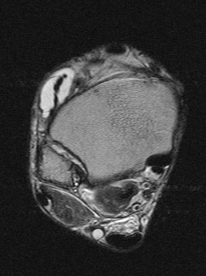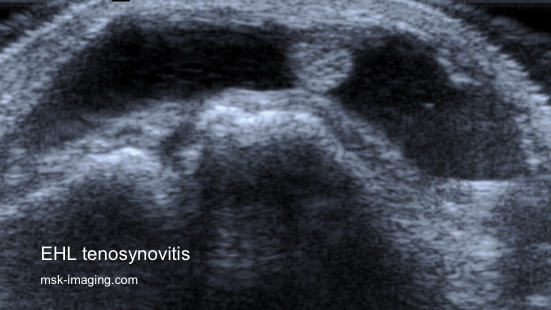Tendinopathy of the tibialis anterior tendon is rare, but may occur as an overuse injury.
The earliest changes are found around the tendon where it abuts the retinacula.
Fluid may gather around the tendon though it will be constrained in the area where the retinaculum compresses it
In some cases, the tibialis anterior tendon synovial sheath may be uninvolved, but there is thickening of the retinaculum leading to a type of stenosing tenosynovitis
This process may also progress to tendon rupture
Isolated enthesopathy may involve the distal portion of tibialis anterior tendon at its insertion. New bone formation may be present with bony ingrowth into the tendon
The commonest site for tibialis anterior rupture is in the space between the superior and inferior retinaculum. Attention has been drawn to an area of poor vascularity within the tendon in this area. Rupture may also occur beneath the oblique superomedial limb of the inferior extensor retinaculum. A further site of tendon injury is at its insertion into the medial cuneiform. It is not uncommon to identify enthesophyte formation in this location which, if marked, may abrade the tendon leading to rupture. Symptoms of anterior tibialis tendon rupture are often subtle. This is because the loss of dorsiflexion resulting from the injury may be compensated by other tendons. A common presentation is of an anterior mass, often sufficiently prominent to lead to concerns that a soft tissue tumour is present
Injuries to the extensor hallucis longus (EHL) are relatively uncommon and the majority are secondary to laceration rather than the result of overuse or misuse injury. The typical history is a knife dropping unto the patient’s foot. Other causes of laceration include the so-called “boot-top injuries” from its occurrence in ice hockey. Indirect or closed injury tends to occur in predictable locations. It has been described with martial arts, particularly taekwondo where there is forced flexion against resistance. Rupture at the level of the metatarsophalangeal joint may be due to impingement against osteophytes perhaps augmented by tendon fixation within the extensor hood. Rupture at the insertion has also been reported in taekwondo. Predisposing conditions to rupture include chronic tendinopathy, steroid injection, chronic disease or interference in blood supply. Occasionally an accessory tendon may be detected close to the insertion of the extensor hallucis longus tendons.
Like impingement of the extensor hallucis longus, stenosing tenosynovitis of the extensor digitorum longus (EDL) tendon occurs most commonly where the tendon is contained within an extensor retinaculum. Impingement against the inferior retinaculum is often referred to as ultramarathon ankle. In addition to mechanical factors, the presence of osteophytes or synovitis arising from the head of the talus, or the talsonavicular joint, may contribute to impingement. The clinical features are localised to the area of the talonavicular joint and the ultrasound findings are typical of tendinopathy elsewhere


